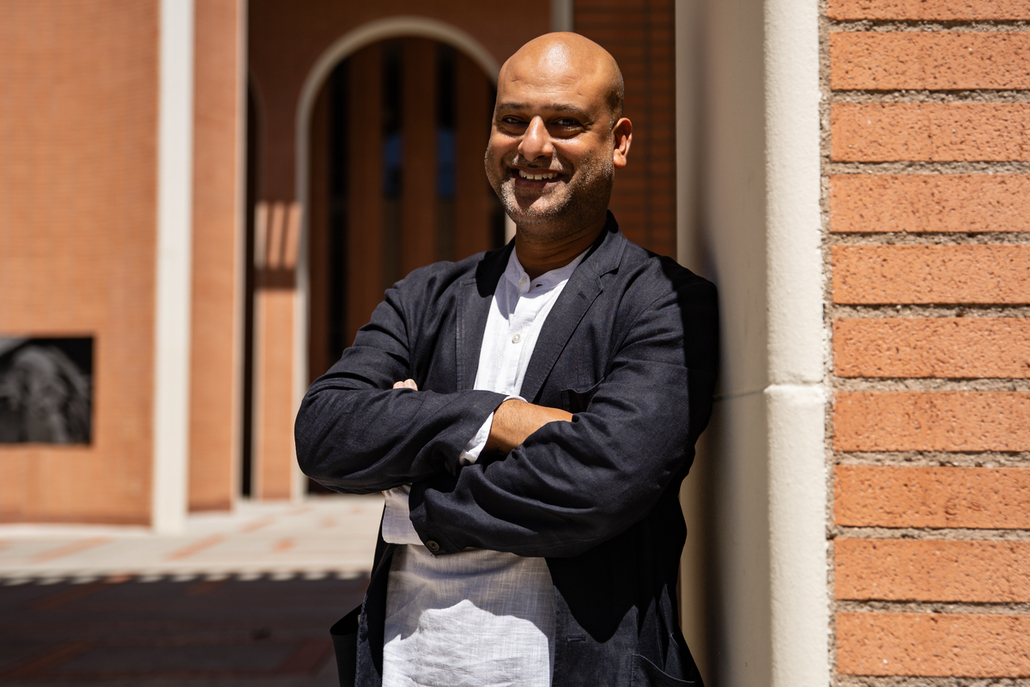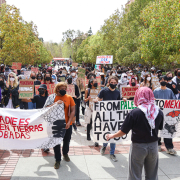The new curriculum is a sign of progress, but students say it is just the beginning in a series of long-overdue reforms.
Indra Mukhopadhyay had been teaching at USC for about 14 years now, and one thing had stuck out to him: In the 140-plus years since its establishment, USC still did not have a South Asian studies degree — not even a minor.
For the last five years, Mukhopadhyay’s voice advocating for change reached a few, then reached many — propelling a movement to recognize that together, faculty and students can make the change they wish to see at their university.
“In my academic training, I was at the University of Michigan. I studied Sanskrit at Harvard, I did my PhD at UCLA. And all these institutions, all of USC’s peer institutions have had some kind of department program or center in South Asian Studies for generations,” Mukhopadhyay, an associate professor of writing in the Dornsife College of Letters, Arts and Sciences, told me. “So it was sort of surprising to me that USC didn’t have one. And, I’m the kind of person who wants to contribute and wants to see what I can do.”
Mukhopadhyay set out to campaign for a South Asian studies minor by gaining support among faculty and submitting funding proposals for the program. Through the gradual process, he realized that the cause had not yet gained the supporters it needed: students.
“There were students on campus who wanted to see more South Asian representation [and] classes in the institution,” Mukhopadhyay told me. “So, I was put in touch with them, and together we kind of developed a vision.”
The student leaders reached out to 15 other student organizations that were affiliated with South Asia in different ways, composing an open letter of support for the minor in South Asian Studies.
Among these student leaders are Suhas Peela, a recent graduate who majored in international relations and global business, and Rudra Saigal, a junior majoring in economics-mathematics. Seeing that they could aid the cause by connecting with South Asian affiliated student organizations around campus, Peela and Saigal founded a new student coalition: Students for South Asia.
“When we were signing the petition, we realized that you have this gap where USC is one of the nation’s top 25 schools, but out of all these many schools, it’s probably one of four or five who do not have a South Asian Studies department or South Asian Studies minor,” Saigal told me. “That was what created Students for South Asia in the first place. That’s something that we want to continue pushing towards.”

Aadhya Sivakumar, left, and Rudra Saigal, right. (Drake Lee / Daily Trojan)
With 15 signatures of student support, Mukhopadhyay sent a letter of request to USC’s administration to create the minor. Their petition was approved in May, and the South Asian Studies minor will be hosted in Dornsife School of Religion starting this coming school year.
“I’ve always been painfully aware there’s very few offerings about South Asia, anything to do with South Asia at USC,” James McHugh, chair of the religion department and professor South Asian religion, told me. “Finally giving it some sort of focus and a name … and attracting more students to concentrate in that — hopefully that will help develop and grow various offerings.”
The minor’s approval was a tremendous step, but it was only the first of many. Students for South Asia is also advocating for more South Asian Studies academic inclusion in promoting South Asian languages, as well as a major dedicated to the subject, and increased representation across the board in student assemblies and the Undergraduate Student Government. Most recently, though, the process of drafting the letter has drawn their attention towards creating unity among the South Asian student organizations and bringing more identity-specific programming to campus.
“[Our] third goal is trying to foster collaborative South Asian programming on campus — be it through different departments, different colleges on campus or be it through different clubs — because there’s so many different South Asian organizations,” Saigal told me. “We want to act as a student coalition that can bridge those differences between [the] South Asian community on campus.”
In the development of South Asian education at USC, including all national and religious identities while maintaining an unbiased ground in opposing political and social views is the priority of Students 4 South Asia —all while acknowledging that multiple perspectives questions in South Asian courses are important for historical accuracy and representation.
“South Asian identity is not monolithic. That’s quite an obvious fact,” Peela told me. “But can South Asian education at USC unfold in a way where we might not get it perfectly, but [we still] put the effort in on our end as students to advocate for each other, and the space that we create for South Asians on campus?”
The first effort to make that happen was Brown&, an event for students to hear and share personal experiences of discovering their intersectional identities as South Asians.
“Brown& was basically an identity exploration and story and storytelling event,” Peela told me. “The name ‘Brown&’ basically is about beating the stereotype. There’s a stereotype that’s been associated with brown people, but the event was to use the power of story to create a more inclusive and more diverse narrative of what it means to be South Asian.”
A collaboration between Students 4 South Asia and Project RISHI–an organization that focuses on community service projects in India — Brown& had eight speakers who spoke about topics such as adjusting to a USC student lifestyle, growing in one’s faith, mental and love among other things. One of the speakers, Aadhya Sivakumar, a rising junior majoring in public relations and psychology, was inspired with the turnout of Brown& and the minor’s approval.
“I think there’s definitely going to be a lot of collaboration [between Students 4 South Asia and Project RISHI] in the future,” she told me. “I know I’m definitely planning on working with both just because I genuinely love the causes of each and I think it’s the same for a lot of people in Project RISHI. They really want to help out and get this new organization to where they are.”
That community connection is what Saigal hopes to continue with more events, as the process of creating the coalition has also helped him fulfill personal passions and realize future goals as well.
“I think what this minor and what this movement in general has given me is more confidence in my ability to relate to my own identity, and more pride in myself as an Indian [and] as South Asian,” Saigal told me. “It has also given me the ability to explore what South Asia is all about.”
Peela and Saigal both credit Mukhopadhyay’s initiative to install the South Asian Studies minor early on. Mukhopadhyay “created really fertile soil for [them] to water.” This movement proved that there is power in a professor and students demanding an education inclusive of themselves. That remains the goal of Students for South Asia.
“There are other universities that already have South Asian studies,” Peela told me. “We don’t want to just get USC up to that point. We want it to be a leader. There are a lot of important ties between the South Asian diaspora and California, and we think that USC is a great place for that to happen.”











